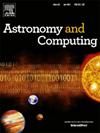New crescent moon detection using Circular Hough Transform (CHT)
IF 1.8
4区 物理与天体物理
Q2 ASTRONOMY & ASTROPHYSICS
引用次数: 0
Abstract
Over 1.5 billion Muslims worldwide rely on a calendar based on the observation of the new crescent moon, particularly during the Hijri calendar months of Ramadhan, Shawal, and Zulhijjah. Accurately detecting the new crescent moon immediately after its conjunction is essential for ensuring the precision of the calendar, but it poses a technical challenge due to the low contrast between the new crescent moon and its background. This study aimed to solve the challenge of reliably identifying the new crescent moon at this critical phase, which is vital for accurately determining important dates that signify religious events. It intended to create and verify a computer vision model that would greatly improves the precision and efficiency of identifying a new crescent moon based on images. This will assist in precisely identifying important dates relevant to Muslim religious practices. The methodology employs image preprocessing techniques such as Gaussian Blur for image smoothing and Adaptive Thresholding for contrast enhancement to optimize the visibility of the crescent moon in a single image. The Circular Hough Transform (CHT) technique was used to accurately detect the new crescent moon, while the OpenCV software package helped to implement all of these methods, thus, providing a strong foundation for precisely identifying the new crescent moon. Findings of this study, which involved observations at Kolej Ugama Sultan Zainal Abidin (KUSZA) Observatory, Teluk Kemang Observatory, and Miri Observatory, indicate that the utilization of image processing techniques results in significant improvements in both the efficiency and precision of identifying and detecting the new crescent moon. These enhancements exceed the performance of conventional digital imaging methods employed during regular observations. The model’s processing rate surpasses the usual observation efficiency and showcases exceptional accuracy in distinguishing images that feature the new crescent moon from those that do not. In conclusion, the proposed model demonstrates an effective and efficient methodology for improving the precision of lunar calendar management and the quick planning of important Islamic religious events in accordance with the lunar cycle. This technological advancement offers a reliable method for accurately seeing the crescent moon, which has important implications for enhancing the precision of lunar-based calendars and coordinating important Islamic religious occasions.
基于圆霍夫变换的新新月探测
全世界有超过15亿的穆斯林使用基于新月观测的历法,特别是在斋月、斋戒节和足节等回历月份。在月相后立即准确地探测新月对于确保日历的准确性至关重要,但由于新月与背景之间的对比度较低,这给技术带来了挑战。这项研究旨在解决在这个关键阶段可靠地识别新月的挑战,这对于准确确定象征宗教事件的重要日期至关重要。它打算创建并验证一个计算机视觉模型,该模型将大大提高基于图像识别新新月的精度和效率。这将有助于准确确定与穆斯林宗教习俗有关的重要日期。该方法采用高斯模糊图像平滑和自适应阈值图像对比度增强等图像预处理技术来优化单幅图像中新月的可见性。利用圆形霍夫变换(CHT)技术对新月进行精确探测,而OpenCV软件包实现了这些方法,为新月的精确识别提供了坚实的基础。在Kolej Ugama Sultan Zainal Abidin (KUSZA)天文台、Teluk Kemang天文台和Miri天文台的观测结果表明,图像处理技术的使用显著提高了识别和探测新新月的效率和精度。这些增强的性能超过了常规观测中使用的传统数字成像方法。该模型的处理速度超过了通常的观测效率,并在区分新月特征和非新月特征的图像方面显示出非凡的准确性。综上所述,该模型为提高阴历管理的准确性和根据阴历周期快速规划伊斯兰重要宗教活动提供了有效和高效的方法。这一技术进步为精确观测新月提供了可靠的方法,对提高月历精度和协调重要的伊斯兰宗教场合具有重要意义。
本文章由计算机程序翻译,如有差异,请以英文原文为准。
求助全文
约1分钟内获得全文
求助全文
来源期刊

Astronomy and Computing
ASTRONOMY & ASTROPHYSICSCOMPUTER SCIENCE,-COMPUTER SCIENCE, INTERDISCIPLINARY APPLICATIONS
CiteScore
4.10
自引率
8.00%
发文量
67
期刊介绍:
Astronomy and Computing is a peer-reviewed journal that focuses on the broad area between astronomy, computer science and information technology. The journal aims to publish the work of scientists and (software) engineers in all aspects of astronomical computing, including the collection, analysis, reduction, visualisation, preservation and dissemination of data, and the development of astronomical software and simulations. The journal covers applications for academic computer science techniques to astronomy, as well as novel applications of information technologies within astronomy.
 求助内容:
求助内容: 应助结果提醒方式:
应助结果提醒方式:


